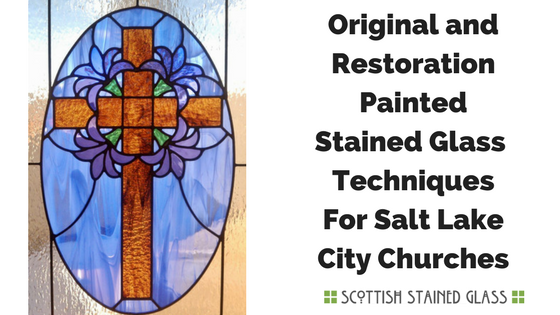
As many people here in Salt Lake City know, painted stained glass is an age-old tradition that is lovely and abundant on churches in the area. At Scottish Stained glass, we can proudly say that we have a deep working knowledge of this artform and love sharing our knowledge with the community at large. The process for painting stained glass is absolutely fascinating and requires years of experience in order to master. We know because we have spent the last 3 decades learning this delicate craft and excel in painted stained glass techniques both old and new. So, whether you are looking for painted glass restoration or an original creation read on to get a better understanding of the complex processes that will be involved in crafting your one-of-a-kind painted stained glass masterpiece.
While painted stained glass may look simple to the untrained eyes is actually quite a complex art form. The beautiful look you see on churches throughout the Salt Lake City is actually achieved through a complicated process that sometimes looks more like science than art. This is because the colors you see on painted stained glass are actually achieved by way of different chemical interactions of minerals and oils.
The artist starts with colored glass and then applies special black paint onto it. The piece of glass is then fired in our kiln at 1250-1450 for a couple of hours until the paint melts into the glass. After the firing, the glass has the lovely bold colors you are used to seeing on stained glass and the paint is now a part of the glass and will never rub off or be removed.
The second method involves clear glass. During this process, colors are painted on a clear piece of glass one at a time and then fired in between layers of color. This allows the artist to build up layers of shading or color and give the piece depth.
*Interesting fact: Any color that involves the use of yellow can be particularly difficult in this method as the chemical used for yellows color (silver staining) is very toxic and will destroy other colors. For this reason, when trying to achieve the color green for instance, the toxic yellow must be painted on the opposite side of the glass as the blue paint in order to keep the yellow from damaging the blue paint.
At Scottish, matching styles on restoration projects is always a challenging but fun challenge. Figuring out what type of techniques the original artist used is an adventure and one we love going on. For instance, old artists would sometimes paint glass black and then use a stick to rub off part of the paint to give the piece texture, or to put in elements like blades of glass. To figure out the final look, our artists sometimes do numerous iterations to make sure you painted stained glass restoration matches the original precisely.
Learn more about the history of stained glass here or watch the video below.
We would love to hear about your painted stained glass restoration project or an idea you have for an original piece. Contact us today to get started!
© Scottish Stained Glass 2000- All Rights Reserved | A Part of Scottish Group Companies